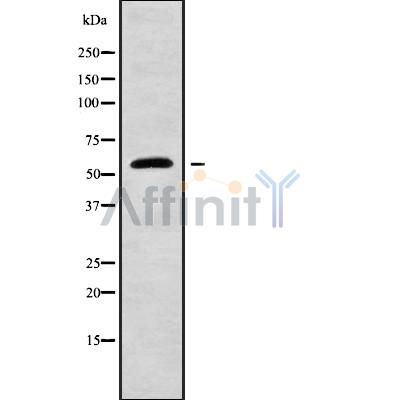ANGPT4 Antibody - #DF9209
| Product: | ANGPT4 Antibody |
| Catalog: | DF9209 |
| Description: | Rabbit polyclonal antibody to ANGPT4 |
| Application: | WB IHC IF/ICC |
| Reactivity: | Human, Mouse |
| Prediction: | Pig, Zebrafish, Bovine, Horse, Sheep, Rabbit, Dog, Chicken |
| Mol.Wt.: | 57 kDa; 57kD(Calculated). |
| Uniprot: | Q9Y264 |
| RRID: | AB_2842405 |
Product Info
*The optimal dilutions should be determined by the end user. For optimal experimental results, antibody reuse is not recommended.
*Tips:
WB: For western blot detection of denatured protein samples. IHC: For immunohistochemical detection of paraffin sections (IHC-p) or frozen sections (IHC-f) of tissue samples. IF/ICC: For immunofluorescence detection of cell samples. ELISA(peptide): For ELISA detection of antigenic peptide.
Cite Format: Affinity Biosciences Cat# DF9209, RRID:AB_2842405.
Fold/Unfold
AGP4; ANG-3; ANG-4; ANG3; ANG4; Angiopoietin 3; Angiopoietin 4; Angiopoietin-3; Angiopoietin-4; ANGP4_HUMAN; ANGPT4; dJ824F16.2 (angiopoietin 4); MGC138181; MGC138183; OTTHUMP00000029947;
Immunogens
A synthesized peptide derived from human ANGPT4, corresponding to a region within the internal amino acids.
- Q9Y264 ANGP4_HUMAN:
- Protein BLAST With
- NCBI/
- ExPASy/
- Uniprot
MLSQLAMLQGSLLLVVATMSVAQQTRQEADRGCETLVVQHGHCSYTFLLPKSEPCPPGPEVSRDSNTLQRESLANPLHLGKLPTQQVKQLEQALQNNTQWLKKLERAIKTILRSKLEQVQQQMAQNQTAPMLELGTSLLNQTTAQIRKLTDMEAQLLNQTSRMDAQMPETFLSTNKLENQLLLQRQKLQQLQGQNSALEKRLQALETKQQEELASILSKKAKLLNTLSRQSAALTNIERGLRGVRHNSSLLQDQQHSLRQLLVLLRHLVQERANASAPAFIMAGEQVFQDCAEIQRSGASASGVYTIQVSNATKPRKVFCDLQSSGGRWTLIQRRENGTVNFQRNWKDYKQGFGDPAGEHWLGNEVVHQLTRRAAYSLRVELQDWEGHEAYAQYEHFHLGSENQLYRLSVVGYSGSAGRQSSLVLQNTSFSTLDSDNDHCLCKCAQVMSGGWWFDACGLSNLNGVYYHAPDNKYKMDGIRWHYFKGPSYSLRASRMMIRPLDI
Predictions
Score>80(red) has high confidence and is suggested to be used for WB detection. *The prediction model is mainly based on the alignment of immunogen sequences, the results are for reference only, not as the basis of quality assurance.
High(score>80) Medium(80>score>50) Low(score<50) No confidence
Research Backgrounds
Binds to TEK/TIE2, modulating ANGPT1 signaling. Can induce tyrosine phosphorylation of TEK/TIE2. Promotes endothelial cell survival, migration and angiogenesis.
Secreted.
Highly expressed in the lung with much lower levels found in other tissues.
Research Fields
· Environmental Information Processing > Signal transduction > MAPK signaling pathway. (View pathway)
· Environmental Information Processing > Signal transduction > Ras signaling pathway. (View pathway)
· Environmental Information Processing > Signal transduction > Rap1 signaling pathway. (View pathway)
· Environmental Information Processing > Signal transduction > HIF-1 signaling pathway. (View pathway)
· Environmental Information Processing > Signal transduction > PI3K-Akt signaling pathway. (View pathway)
Restrictive clause
Affinity Biosciences tests all products strictly. Citations are provided as a resource for additional applications that have not been validated by Affinity Biosciences. Please choose the appropriate format for each application and consult Materials and Methods sections for additional details about the use of any product in these publications.
For Research Use Only.
Not for use in diagnostic or therapeutic procedures. Not for resale. Not for distribution without written consent. Affinity Biosciences will not be held responsible for patent infringement or other violations that may occur with the use of our products. Affinity Biosciences, Affinity Biosciences Logo and all other trademarks are the property of Affinity Biosciences LTD.


